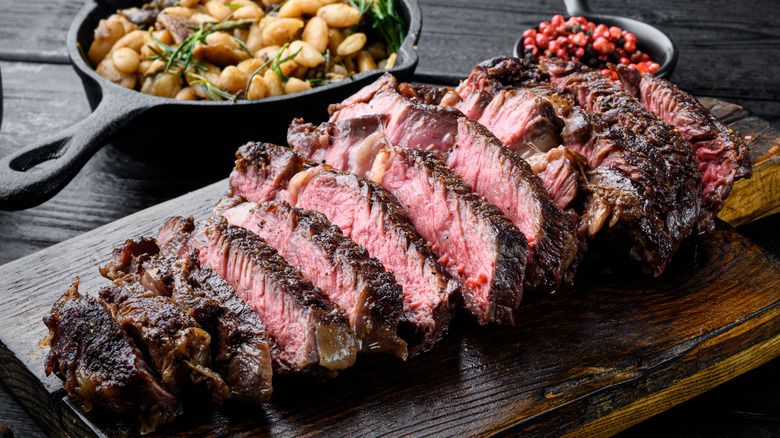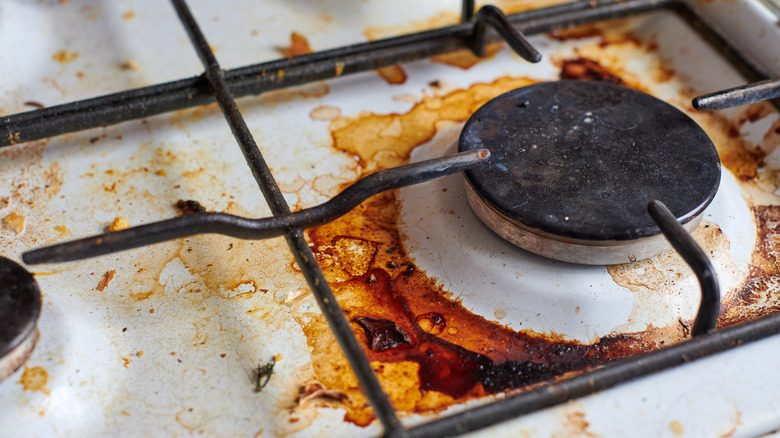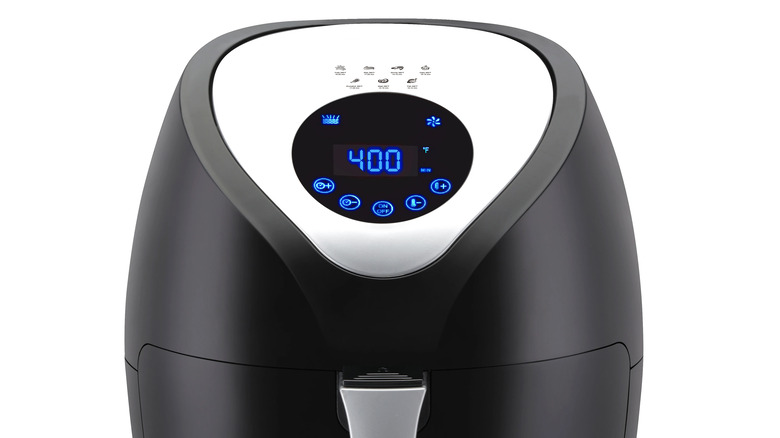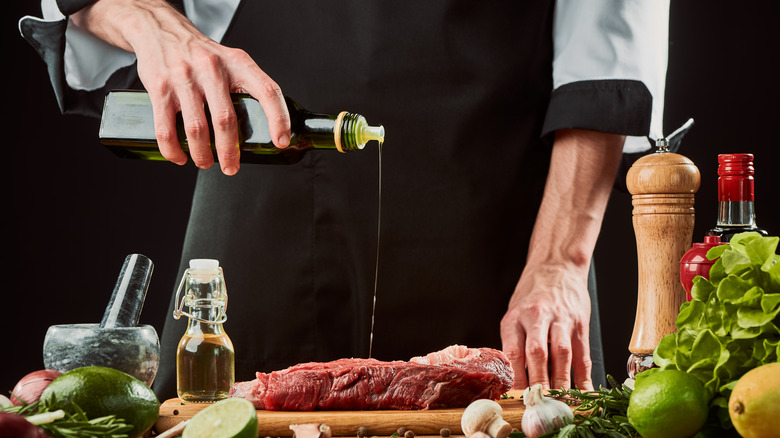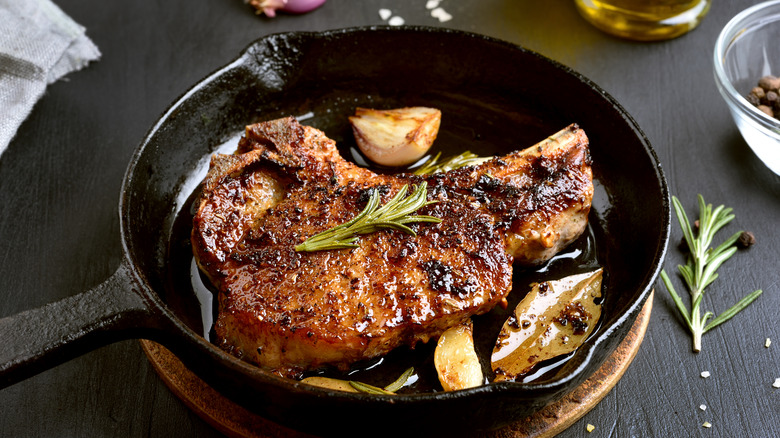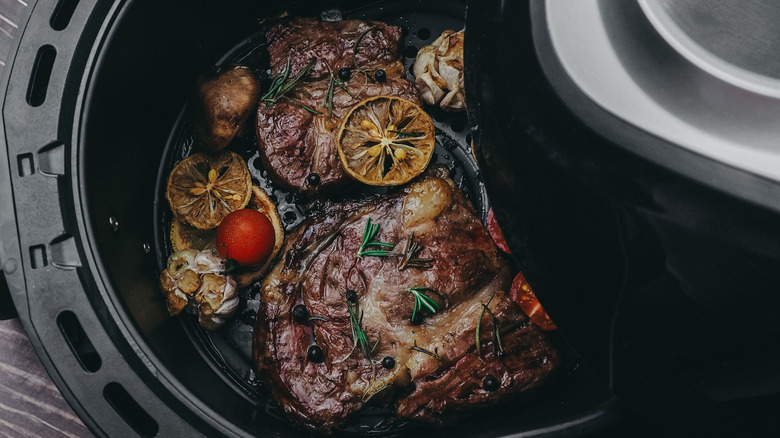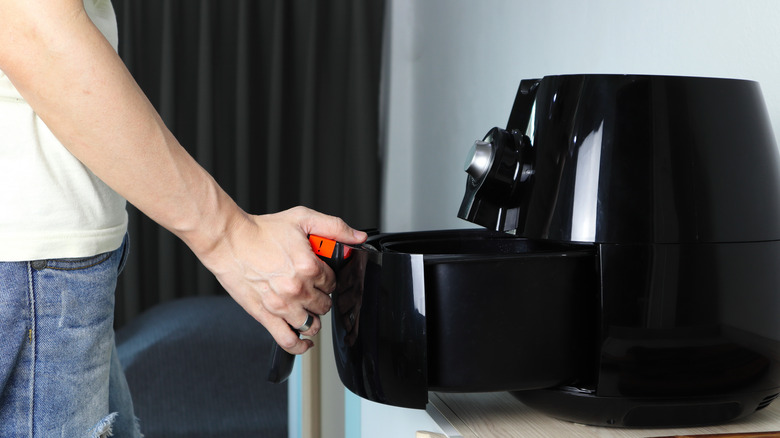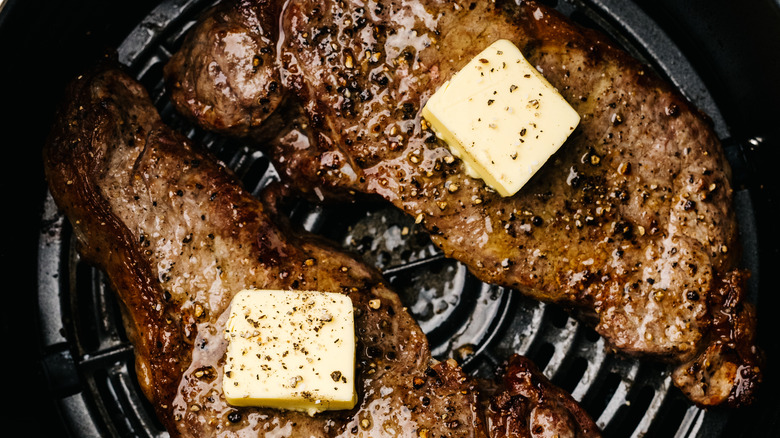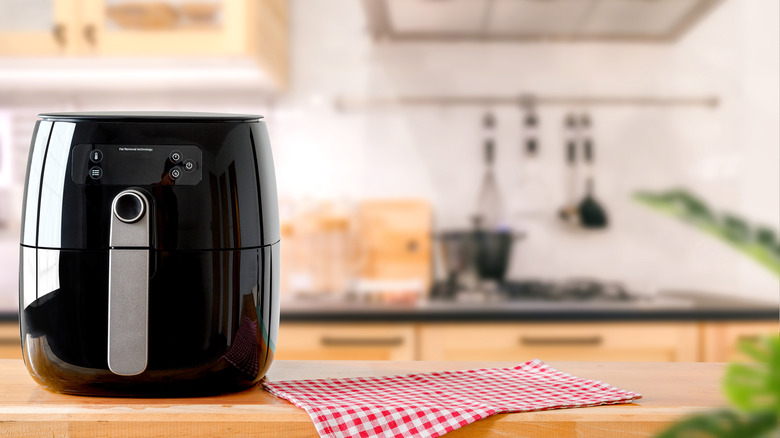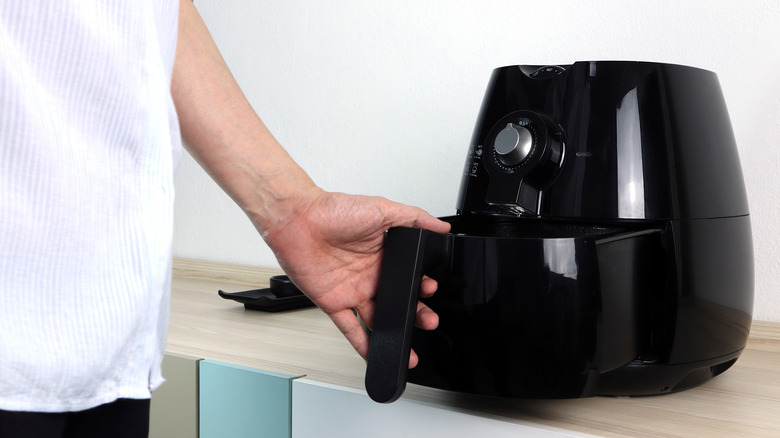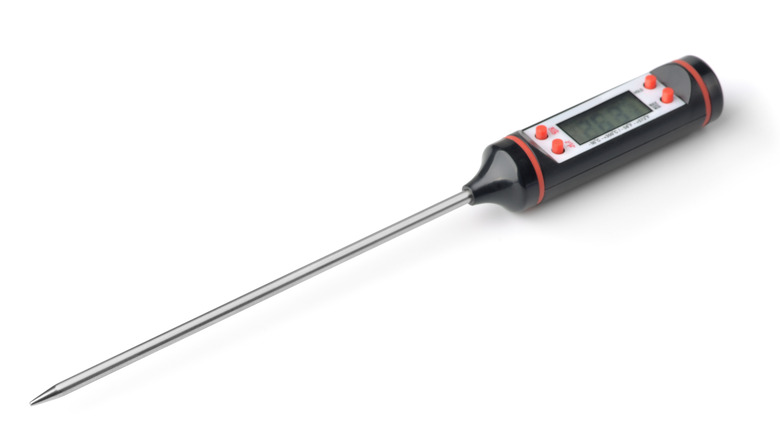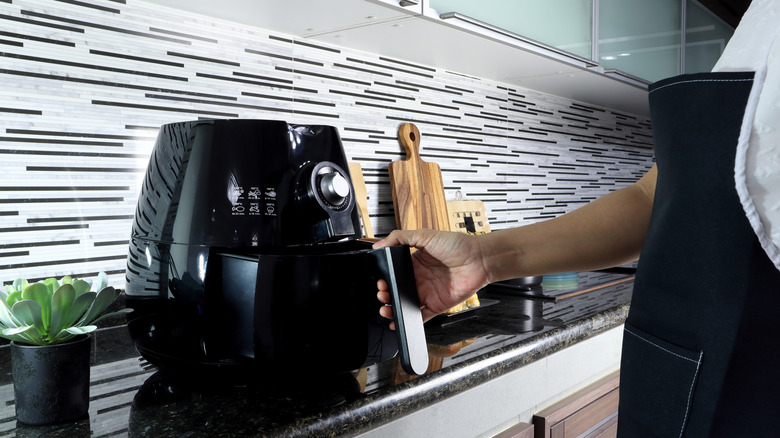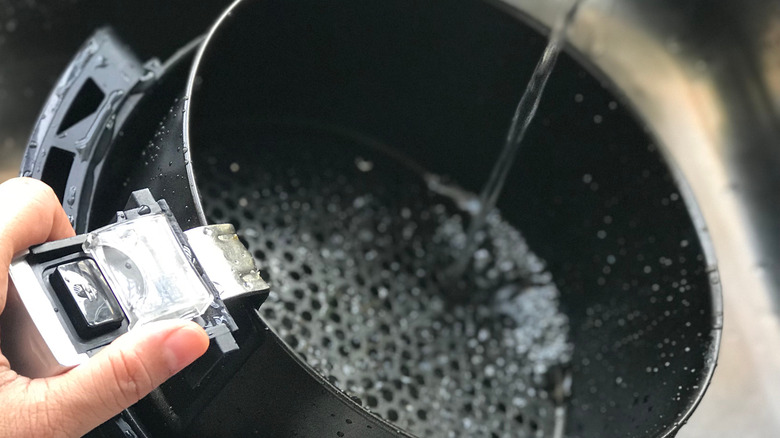Everything You Need To Know About Cooking Steak In An Air Fryer
In just over a decade, air fryers have gone from relative culinary obscurity to a common household appliance. As the years go by, more people are catching on to the air fryer's versatility. Need a quick way to reheat some leftover pizza? Wanna roast up some broccoli real quick? In the mood for sticky, succulent, caramelized ribs? Your air fryer can gracefully pull off all of these missions with amazing results. But have you ever considered cooking a steak with it?
While it's always a treat to visit your favorite steakhouse, it's also nice to save some cash and cook at home. When you're in the mood to cook a delicious steak, your first impulse is probably to throw it on the grill or baste it with butter in a cast-iron pan. While those methods are certainly tried and true, your air fryer can achieve remarkably similar results, and the process is much more simplified. And let's be honest: Making a tasty dinner in the easiest way possible is always the name of the game. So grab yourself a gorgeous ribeye and fire up that magical kiln on your countertop. Here's everything you need to know about cooking steak in an air fryer.
Cooking your steak in an air fryer is much less messy
We've all been there. You've just prepared an awesome steak dinner and you're looking around at the aftermath: a splattered stove top or a dirty grill and streaks of bloody steak juice smeared around the kitchen like a crime scene. Yes, you have a beautifully cooked steak — and we applaud your effort. But a good question to ask yourself while you're cooking (and throughout life in general) is: Was the end result worth the mess you made?
Your air fryer can cook steak in the same amount of time as those other more traditional methods, but instead of leaving you with greasy constellations of myoglobin driblets spattered everywhere, the mess is totally self-contained inside that miraculous dome of swirling heat — and the removable trays and baskets for cooking are easy to clean after a short soak. When you factor in much less cleanup afterward, there's no doubt that cooking steak in your air fryer saves you plenty of time and effort. You can rest easy after your steak dinner and get back to daydreaming about the next dish you'd like to try cooking with it.
Remember to preheat your air fryer
Your steak is liberally seasoned with salt and ready for some action. Should you just throw it in the air fryer, set the temperature, and walk away? Not so fast. Just like your oven, your air fryer should be preheated before cooking (via Insider). This is an easy step to miss (and some say it's not needed), but it can make a difference in how your steak ends up cooking. Here's the good news: Because air fryers tend to be significantly smaller than a convection oven, it shouldn't take too long to reach your desired temperature.
Why is preheating your air fryer so important for cooking your steak? For dishes like roasts or lasagnas that require a longer cook time, preheating your oven probably isn't as important. But when it comes to dishes that need to be cooked quickly, like a 10 to 12-minute steak, it can make a difference in the texture. If you put your steak in a cold air fryer and set the temperature, it's may end up less juicy and affect the overall level of doneness you're aiming for. As Food 52 puts it, "cooking times will be lengthened by about the time it takes to preheat your oven in the first place," — and the same goes for air fryers. This is especially risky with baked goods, but can also apply to other dishes that don't require a long time in the oven, like your steak. Bottom line: Your air fryer shouldn't take too long to warm up, and your steak is more likely to come out better if you remember to preheat it.
Lightly coat your steak in oil
Most steak recipes call for a brush of oil before you season it. Lightly coating your steak in oil serves two main purposes: It gives your seasoning an extra glaze of fat to cling to, which helps the it stick to the meat, allowing the seasoning to permeate the steak more easily. And according to Delish, adding oil to your steak before you cook it will also help you achieve a nice, even crust. A big part of what makes a steak exceptional is the difference in texture between the crusty exterior of the beef and the soft, juicy tenderness on the inside. According to Insider, air fryers work by circulating hot air, so when your steak is coated in oil, all of that heat bakes the oil, which helps evenly roast the surface of the beef.
Another important thing to consider is the type of oil that you use. Most people tend to use olive oil universally in just about everything when they cook, and while it's true that olive oil is versatile and has a ton of useful applications, it's really not your best choice for cooking steak. This is because of olive oil's smoke point, which is on the lower side (via MasterClass). This means that olive oil will burn and smoke at a lower temperature compared to some other oils. Because cooking a steak requires higher temperatures, you should use an oil with a higher smoke point in order to prevent the oil from burning and smoking during the cooking process. We'd like to recommend avocado oil, which has a smoke point of about 520 degrees Fahrenheit.
Cooking your steak in an air fryer is healthier than pan-searing
One of the most common ways to cook a steak is to pan-sear and baste it in a cast iron skillet. This method truly does produce an amazing steak, but it also leaves you with a bit of a mess — not to mention that soaking beef in sizzling butter isn't exactly the healthiest way to cook. According to Healthline, air fryers can cut the fat content of your food because they need significantly less oil than some other methods of cooking.
Eating red meat is already an indulgence, and according to the National Institutes of Health, it's also risky for your health if consumed on a regular basis. Why not scale back on some of the other variables you can control and make it a little healthier? An air fryer can achieve tasty results with just a fraction of the oil, which is much better for your heart, via WebMD.
Circulation is the secret when cooking steak in an air fryer
It's easy to sit back and let your air fryer do all the work without thinking about the intricacies of the physics that make its magic possible. According to Insider, the secret to the air fryer's success is circulation. The circulation of heat inside of your air fryer triggers the Maillard reaction, which is a chemical reaction that generates the browning that produces the complex flavors and textures we've all come to love so much.
As it turns out, your air fryer isn't really a fryer at all. It's really just a mini-convection oven that cooks food through the circulation of fan-powered heat. The heat circulating in your air fryer around your steak produces a similar result to other methods like frying and grilling, via Insider. Because your steak is elevated in a basket, heat can easily swirl around the entire cut of beef, ensuring that the whole piece of meat is evenly cooked.
Add a little water to the drawer under the basket
Steak is a juicy hunk of meat, and when it's cooking there is bound to be some level of grease involved. When you cook over an open flame on the grill, all of that grease falls into the fire and flares up. In the same way, the grease from the steak in your air fryer will drip down into the bottom of your air fryer's basket. Because most air fryer steak recipes will usually call for a temperature between 350 F to 400 F, you'll be cooking at a higher temperature depending on the level of doneness you're looking for — and at those higher temperatures, the grease can burn and smoke inside of your air fryer.
The good news is that there's an easy way to prevent all that burning and smoking. According to Everyday Family Cooking, adding a few tablespoons of water to the drawer underneath the basket will cool down the grease from the steak and stop your air fryer from smoking. But be sure to only add a few tablespoons — just enough to cool down any grease droplets. Adding too much water will create a steaming effect, and that's obviously not what we're looking for here.
Don't overcrowd the basket
When you're feeling extra hungry, it's tempting to just mindlessly pack your air fryer so full that you have a basket bursting to the brim with food waiting for you. But jamming too much food into your air fryer and overcrowding the basket is a big mistake. This is because overcrowding your air fryer basket with food can lead to uneven cooking (via America's Test Kitchen). Imagine ribeyes that are well done on one side and medium rare on another. Doesn't sound very appealing, does it? This can totally happen if you pack too much steak into your air fryer basket.
If you're cooking more than one steak, be cautious about how they're situated in the basket and don't press them up against each other. Depending on the size of your steak, you may need to cut it in half to assist with airflow and help it cook evenly. The air fryer is already taking most of the work out for you — all you really have to do is make sure the steak in your basket isn't overcrowded.
Give your air fryer room to vent
Kitchen countertops tend to get cluttered, so it's easy to overlook how much room your air fryer has around it. One common mistake people might make is pushing their air fryer too close to the wall. Since air fryers tend to be bigger and kind of clunky, people may try to position them out of the way from their normal food preparation area, banishing them to a far corner of the kitchen. While it's fine to store your air fryer like this, it's important to give your air fryer enough room to vent when it's actually in operation. Generally, it's recommended giving your air fryer at least five inches of space around the exhaust vent to prevent it from overheating (via Kitchn).
What if your air fryer overheats? A few things can happen, and none of them are good. According to Air Fryer Bro, at the very least it can flood your kitchen, and possibly the rest of your home, with smoke. There's also potential to cause a fire — and we can all agree that setting your house ablaze probably isn't the best way to cook that steak of yours.
Flip your steak and give the air fryer a gentle shake
One of the big advantages of using an air fryer is how low-key the cooking process is. While it's true that using an air fryer is a mostly passive cooking experience, there is still some level of vigilance and involvement required on your part. Aside from preheating your air fryer and adding some water to the bottom of the basket, you should also be sure to rotate and flip your steak about halfway through — this will ensure both sides get evenly cooked. According to Kitchn, flipping your steak halfway through cooking will allow it get golden brown on every side.
It's also worth remembering to give the air fryer basket a gentle shake. According to Best Air Fryer Hub, shaking your air fryer basket halfway through the cooking process will help you get a more even result. Shaking the air fryer basket can also stop your food from sticking to the basket (via Hamilton Beach).
Use a digital thermometer
We all tend to have specific preferences for how we like our steak cooked, and missing the mark can end up ruining what would've been an enjoyable meal. If you're taking the time to make steak that you've spent your hard-earned money on, isn't it always worthwhile to put in a little extra effort to make sure it's cooked just how you like it? We think so too.
Using a digital meat thermometer will allow you to easily monitor the internal temperature of your steak in the air fryer so that you can cook it to your exact taste (via Taste of Home). At that point, the name of the game is knowing what internal temperature you're looking for. Certified Angus Beef recommends 125 F for rare, 135 F for medium rare, 145 F for medium, 150 F for medium well, and 160 F or above for a well done steak.
Reheating your leftover steak
In the unlikely event that you end up leaving some delicious steak behind, how would you normally heat it back up? You may opt for a quick sear in a pan on the stovetop, but that would require some extra work and a few dirty dishes. And for the love of all that's holy, we'd like to think you wouldn't dare use your microwave on such a beautiful, pricey cut of beef. You're also not very likely to fire up the grill again just for leftovers — and besides, the flames from the grill may end up drying it out (via Chicago Steak Company).
The truth is that your trusty air fryer is the perfect vessel to reheat any leftover steak. Being in a little self-contained sphere of churning heat is a great way to maintain the texture of your steak while also warming it up enough to eat. Just note that according to the US Department of Health, it's important to make sure the internal temperature of your steak reaches 145 F for at least 15 seconds.
How to clean your air fryer after cooking a steak
You've just enjoyed a perfect steak, and now it's time to face reality: clean-up time. Keeping your air fryer in good working condition requires you to give it a proper cleaning after each use (via Reader's Digest). It's important to properly clean your air fryer to keep it sanitary and so that the fans are clean to air can circulate well during your cooking sessions. A dirty air fryer can also circulate filthy crumbs around inside, dusting your food with nasty debris.
The good news is that cleaning your air fryer is actually pretty easy work. The first step: Unplug the air fryer and make sure it's cool before you handle it to avoid being burned. Remove the basket, tap out any debris, and wipe out the inside with a paper towel. According to Reader's Digest, most air fryer baskets can go right into the dishwasher, but be sure to check your instruction manual to see if your brand is dishwasher safe. To clean the interior, use a wet sponge with just a little bit of dish soap. If you notice any buildup, put a little elbow grease into it. A little baking soda paste can help break down any baked on grease. After it's been scrubbed, give the interior a wipe with a wet cloth and call it a day.
